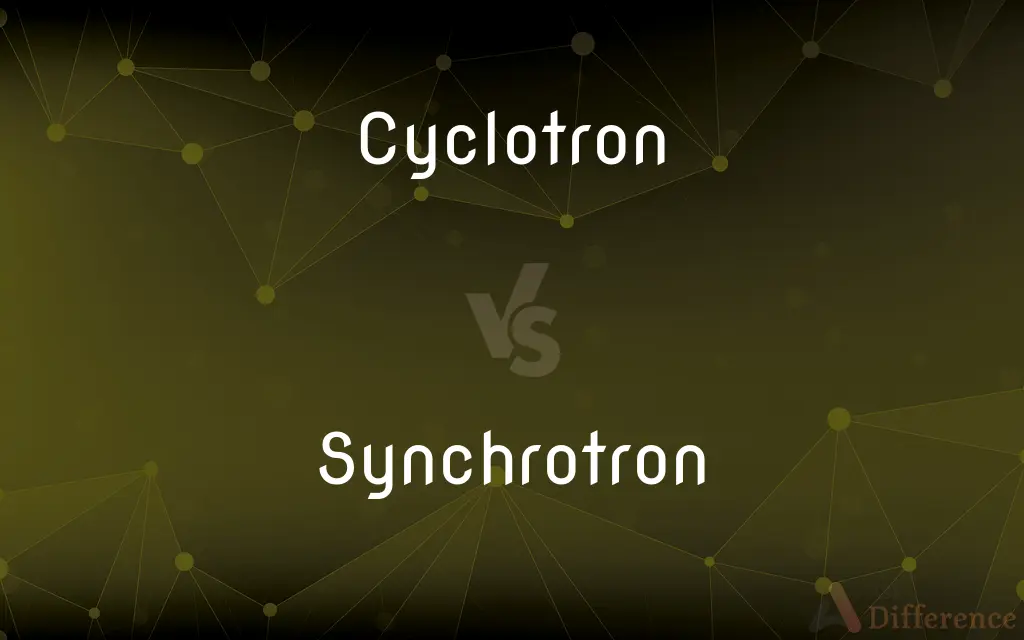Cyclotron vs. Synchrotron — What's the Difference?
By Tayyaba Rehman — Updated on September 27, 2023
A "Cyclotron" accelerates charged particles in a spiral using a fixed magnetic field, while a "Synchrotron" uses varying magnetic fields to accelerate particles in a ring.

Difference Between Cyclotron and Synchrotron
Table of Contents
ADVERTISEMENT
Key Differences
Both the Cyclotron and the Synchrotron are particle accelerators, but they employ different mechanisms and designs. The Cyclotron utilizes a fixed magnetic field and an alternating electric field to propel charged particles outward in an expanding spiral. This design is especially efficient for certain applications, allowing the particles to gain energy in compact devices.
On the other hand, the Synchrotron works on a slightly more complex principle. Rather than a spiral path, particles move in a circular trajectory within the Synchrotron. As particles are accelerated, magnetic fields are varied synchronously to keep the particles moving in a circular path. This leads to very high energy levels being achievable in a synchrotron.
It's essential to understand that while both devices accelerate particles, the Cyclotron tends to be more suitable for lower energy applications due to the spiral path's limitations. As particles become relativistic (approaching the speed of light), it's challenging to maintain their acceleration in a cyclotron. This is where the Synchrotron shines, accommodating relativistic speeds and offering much higher energy levels.
Another crucial distinction is in their physical structure. The Cyclotron typically exhibits a more compact, circular design, while the Synchrotron can span large distances, sometimes even kilometers, due to its need to accommodate varying magnetic fields and achieve higher energy levels.
In summary, both the Cyclotron and the Synchrotron play pivotal roles in modern physics, but they cater to different energy levels and applications, with the cyclotron being more compact and the synchrotron achieving higher energies.
ADVERTISEMENT
Comparison Chart
Design
Spiral trajectory
Ring/Circular trajectory
Magnetic Field
Fixed
Varying synchronously
Energy Levels
More suitable for lower energy applications
Can achieve very high energy levels
Size
Typically more compact
Can be very large, spanning kilometers
Particle Path
Expanding spiral
Circular with synchronous varying magnetic fields
Compare with Definitions
Cyclotron
Uses a fixed magnetic field
The cyclotron's fixed magnetic field differentiates it from other accelerators.
Synchrotron
A device accelerating particles in a ring
The large synchrotron was used for high-energy experiments.
Cyclotron
Works on non-relativistic particles
Due to its design, a cyclotron is best for non-relativistic particles.
Synchrotron
Employs synchronized fields for acceleration
The synchrotron's synchronized fields allow for precise control over particle paths.
Cyclotron
A compact particle accelerator
The lab had a small cyclotron for basic research.
Synchrotron
Uses varying magnetic fields
In a synchrotron, magnetic fields change to keep particles on track.
Cyclotron
Employs alternating electric field for acceleration
The cyclotron's alternating electric field is essential for its functioning.
Synchrotron
Suitable for very high energy levels
Synchrotrons can achieve energies impossible for cyclotrons.
Cyclotron
A device to accelerate charged particles in a spiral
Scientists used a cyclotron for the experiment.
Synchrotron
Can span large distances
The facility had a synchrotron spanning several kilometers.
Cyclotron
A cyclotron is a type of particle accelerator invented by Ernest O. Lawrence in 1929–1930 at the University of California, Berkeley, and patented in 1932. A cyclotron accelerates charged particles outwards from the center of a flat cylindrical vacuum chamber along a spiral path.
Synchrotron
A synchrotron is a particular type of cyclic particle accelerator, descended from the cyclotron, in which the accelerating particle beam travels around a fixed closed-loop path. The magnetic field which bends the particle beam into its closed path increases with time during the accelerating process, being synchronized to the increasing kinetic energy of the particles.
Cyclotron
An early particle accelerator in which charged subatomic particles generated at a central source are accelerated spirally outward in a plane perpendicular to a fixed magnetic field by an alternating electric field. A cyclotron is capable of generating particle energies between a few million and several tens of millions of electron volts.
Synchrotron
An accelerator in which charged particles are accelerated around a fixed circular path by an electric field and held to the path by an increasing magnetic field.
Cyclotron
An early particle accelerator in which charged particles were generated at a central source and accelerated spirally outward through a fixed magnetic field and alternating electric fields.
Synchrotron
(physics) A form of cyclotron in which charged particles are accelerated by an electric field that is synchronized with a magnetic field that keeps them in a circular path.
Cyclotron
A particle accelerator that imparts energies of several million electron-volts to rapidly moving particles; it is used in investigations in nuclear physics and particle physics.
Synchrotron
Cyclotron in which the electric field is maintained at a constant frequency
Cyclotron
An accelerator that imparts energies of several million electron-volts to rapidly moving particles
Common Curiosities
Which one uses a spiral path for particles?
Cyclotron propels particles in a spiral path.
Why is a Cyclotron more compact?
Due to its spiral path design and fixed magnetic field.
What kind of magnetic field does a Synchrotron use?
A Synchrotron uses varying magnetic fields synchronously.
Can Synchrotrons achieve very high energy levels?
Yes, Synchrotrons can achieve much higher energies than cyclotrons.
Which accelerator is better for non-relativistic particles?
Cyclotron is more suitable for non-relativistic particles.
Are Synchrotrons always large in size?
They can be quite large, sometimes spanning several kilometers.
What physical shape does a Synchrotron typically have?
Synchrotrons have a ring or circular shape.
Are Cyclotron and Synchrotron both particle accelerators?
Yes, both are types of particle accelerators.
Is the magnetic field in a Cyclotron always constant?
Yes, Cyclotrons use a fixed magnetic field.
Can a Cyclotron handle particles moving at speeds close to light?
No, at relativistic speeds, cyclotrons become less efficient.
Why might researchers choose a Synchrotron over a Cyclotron?
For experiments requiring very high energy levels and relativistic speeds.
Share Your Discovery

Previous Comparison
Street vs. Pathway
Next Comparison
Boil vs. BlisterAuthor Spotlight
Written by
Tayyaba RehmanTayyaba Rehman is a distinguished writer, currently serving as a primary contributor to askdifference.com. As a researcher in semantics and etymology, Tayyaba's passion for the complexity of languages and their distinctions has found a perfect home on the platform. Tayyaba delves into the intricacies of language, distinguishing between commonly confused words and phrases, thereby providing clarity for readers worldwide.














































